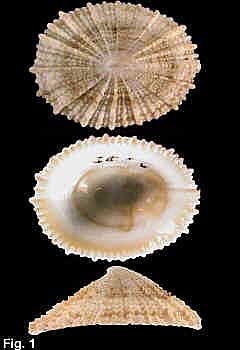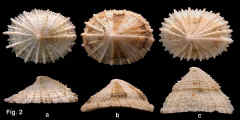|
|
|
|
|
Montfortula rugosa (Quoy & Gaimard, 1834) Description: Shell oval, widest centrally. Variable in height from medium to tall. Apex central, pointing backwards; anterior slope convex, posterior slope convex to concave. Short slit in anterior margin not visible in dorsal view externally. Selenizone a strong raised rib. Sculptured with 30-60 foliaceous radial ribs, usually alternating large and small. Interior with margin crenulate, mushroom shaped scar at apex, groove from apex to slit. External colour white, grey-green or fawn, interior colour variable; uniformly white, patchy green, or with margin and muscle scar outlined in black. Size: Up to 24 mm in length. Distribution: Australian and New Zealand. In Australia, from central Queensland to southern WA, including Tasmania. Habitat: This species is common at mid to low levels on rocky shores. At low tide levels it lives among and on algae and sessile animals, particularly cunjevoi. At low tide under normal conditions it will be found in exposed positions on the rock surfaces and crawling over algae, but during periods of hot weather it takes shelter. At mid-tide levels it is mainly found in pools, sheltering under algae or stones or in crevices. Sexes are separate and eggs and sperm are broadcast into the sea. The spawning occurs over nine months each year (Creese, 1981), without marked peaks of activity. There is no known data on the length of the larval stage, or the dynamics of settlement on the shore, up to when juveniles become visible at a few millimeters in size. The rate of growth was investigated at Cape Banks near Sydney by Creese (1981). He found that juvenile animals were present throughout the year, especially in shallow pools and among coralline algae. Animals reached a size of 12 mm at about a year old, 18 mm at about two years, and 20-22 mm at three years. Animals of 12 mm in size comprised only 10% of the population, so mortality of juveniles was high. Very few animals reached 20 mm, dying from predation or old age before reaching this size. This species is a generalized grazer, feeding on fragments of macroalgae and detritus and some microalgae (Creese, 1978). Analysis of stomach contents found large pieces of the algae Ulva and Gracilaria, as well as sponge spicules, shells of minute bivalves, hydroids and amphipod skeletons. This is in contrast to most of the other intertidal limpets which graze entirely on the thin film of microalgae on rock surfaces; hence substantial food competition does not occur between them. Comparison: Recognised by the marginal slit being very short, not visible in dorsal view, and by the groove from apex to margin internally. Synonymy: Emarginula conoidea Reeve, 1842 Remarks: This species varies widely in the number and strength of radial ribs, and in shell proportions. Dell (1971) reported the ratio of width to length to be 0.67-0.84. and the ratio of height to length to be 0.35-0.63. Fig. 1 Shark Island, Sydney Harbour (DLB2777) Fig. 2 a. Sydney Harbour (C.368644) b. Bundeena, Port Hacking, NSW (C.368713) c. Port Latta, Tasmania (DLB3204) |

